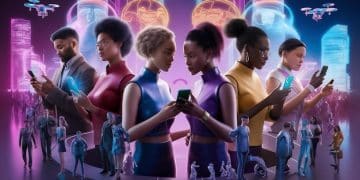Virtual Influencers: Replacing Real People in Advertising?

Anúncios
The advent of virtual influencers presents a complex dynamic within advertising, offering brands innovative engagement opportunities while raising questions about authenticity and potentially redefining the landscape currently dominated by human counterparts.
Anúncios
In a world increasingly shaped by digital innovation, the lines between what is real and what is simulated continue to blur. One of the most fascinating developments in this evolving landscape is the emergence of virtual influencers.
These digital personalities, crafted with meticulous detail and often given compelling backstories, are rapidly taking center stage in the realm of modern marketing and advertising.
The question inevitably arises: The Rise of Virtual Influencers: Are They Replacing Real People in Advertising?
Anúncios
This article delves into the phenomenon, examining their rise, their impact, and what their presence means for the future of brand communication.
The Genesis of Digital Personalities: Understanding Virtual Influencers
The concept of virtual influencers might seem like a recent phenomenon, but its roots can be traced to earlier experiments in digital character creation and CGI.
What sets today’s virtual influencers apart is their sophisticated level of realism, personality development, and the intentional integration into social media ecosystems.
They are not merely animated characters; they are meticulously developed digital entities designed to emulate human behavior, emotions, and even vulnerabilities.
These virtual beings are often conceived by specialized agencies or individual creators who meticulously craft their appearance, voice, and even an entire fictional life story.
This narrative building is crucial, as it allows them to resonate with audiences on an emotional level, much like their human counterparts.
The technological advancements in computer graphics, artificial intelligence, and motion capture have made it possible to create virtual influencers that are almost indistinguishable from real people, blurring the lines in a way previously thought impossible.
Defining Characteristics and Creation Process
Virtual influencers possess several distinguishing features that set them apart. Their appearance can be perfected to an idealized standard, free from blemishes or aging.
Their personalities are carefully curated to align perfectly with specific brand messages or target demographics, offering unparalleled control over their public image. The creation process is intricate and multidisciplinary, involving:
- 3D Modeling and Animation: Highly skilled artists use software to sculpt and animate the virtual character, from facial expressions to body movements.
- Narrative Development: Storytellers craft comprehensive backstories, interests, and aspirations that give the influencer depth and relatability.
- AI Integration: Some virtual influencers, particularly those designed for interactive experiences, employ AI to simulate conversations and adapt to user input.
This meticulous approach ensures that each virtual influencer is not just a pretty face, but a full-fledged personality capable of driving engagement and shaping perceptions.
Their appeal lies in their novelty, their aesthetic perfection, and the control they offer to brands, making them an increasingly attractive proposition in the competitive advertising landscape.
The Allure for Brands: Why Virtual Influencers are Gaining Traction
The advertising industry is in a constant state of flux, always seeking new and innovative ways to capture consumer attention.
In this dynamic environment, virtual influencers have emerged as a compelling solution for several reasons.
Their unique attributes offer benefits that traditional human influencers often cannot match, making them a strategic choice for forward-thinking brands.
One primary appeal lies in control and consistency. Unlike human influencers, who might have their own opinions, personal lives, or even scandals that could damage a brand’s reputation, virtual influencers are entirely brand-controlled.
Their narratives, appearances, and behaviors are meticulously managed, ensuring that every post, every interaction, aligns perfectly with the brand’s message and values.
This level of predictability is invaluable in high-stakes marketing campaigns.
Cost-Effectiveness and Global Reach
While the initial creation of a high-fidelity virtual influencer can be expensive, the long-term operational costs can often be more predictable and potentially lower than continuously hiring A-list human talent for multiple campaigns.
Brands don’t need to worry about travel expenses, accommodation, or the complex logistics often involved in human influencer collaborations.
Furthermore, a virtual influencer can theoretically operate 24/7 across multiple time zones, reaching a global audience without physical limitations.
- 24/7 Availability: Virtual influencers can post content around the clock, continuously engaging diverse audiences worldwide.
- No Personality Clashes: There are no ‘bad days’ or uncooperative behaviors, ensuring smooth campaign execution without interpersonal issues.
- Brand Safety: Reduced risk of controversies, as their actions and words are entirely scripted and approved by the brand.
The ability to create highly specific and niche virtual influencers also allows brands to target very precise demographics, ensuring higher relevance and engagement.
From eco-conscious activists to fashionistas, virtual influencers can embody any persona, making them incredibly versatile tools for diverse marketing objectives.
Their digital nature also makes them inherently adaptable to emerging technologies like augmented reality (AR) and virtual reality (VR), future-proofing advertising strategies.
Challenges and Ethical Considerations: The Flip Side of Digital Influence
While the rise of virtual influencers presents exciting opportunities, it also brings a host of challenges and ethical dilemmas that demand careful consideration.
The very attributes that make them appealing to brands—control, perfection, and artificiality—are also sources of concern for consumers and industry watchdogs.
Navigating these complexities is crucial for the sustainable growth of this burgeoning industry.
One significant challenge revolves around authenticity and transparency. When a virtual influencer promotes a product, is the audience fully aware that they are engaging with a simulated entity rather than a human with genuine experiences?
The lack of clear disclosure can mislead consumers, eroding trust and potentially violating advertising standards.
Regulators are beginning to grapple with how to apply existing advertising guidelines to these new digital entities, ensuring consumers are not deceived.
Defining “Real” and Impact on Human Influencers
The proliferation of virtual influencers also raises profound questions about the nature of influence itself.
If influence can be entirely manufactured, what does that mean for the value placed on genuine human connection and shared experiences?
There’s a debate to be had about whether audiences truly connect with a programmed personality in the same way they connect with a human being who exhibits flaws, growth, and real-world experiences.
- Job Displacement: A major concern is the potential for virtual influencers to displace human models and influencers, impacting livelihoods.
- Ethical Disclosure: The need for mandatory and clear labeling of virtual influencer content to avoid consumer deception.
- Impact on Body Image: Virtual influencers often represent idealized, unattainable aesthetics, potentially exacerbating unrealistic body image standards.
Furthermore, the technology behind virtual influencers, while sophisticated, is not yet flawless. Technical glitches, uncanny valley effects, or simply poorly executed narratives can detract from their appeal.
Brands must invest heavily not only in their creation but also in continuous refinement and engaging content creation to maintain their relevance and avoid appearing superficial or artificial.
The ethical landscape evolving around these digital beings will likely shape their trajectory in advertising.

The Spectrum of Influence: Comparing Virtual to Human Engagement
To truly understand whether virtual influencers are “replacing” real people, it’s essential to compare their engagement models.
Both types of influencers undeniably drive engagement, but the nature and depth of that engagement can differ significantly.
It’s not a zero-sum game, but rather a nuanced interplay of different strengths and weaknesses that brands must weigh.
Human influencers leverage their real-life experiences, vulnerabilities, and personal narratives to build deep, authentic connections with their followers.
This authenticity often translates into higher trust and a more profound emotional resonance, which can be particularly effective for products or services that require a personal endorsement.
Their ability to react spontaneously to real-world events or consumer feedback also creates a dynamic and evolving relationship with their audience.
Advantages and Disadvantages in Engagement
Virtual influencers, by contrast, offer precision and consistency. Their controlled environment allows for flawless execution of campaigns, ensuring every message is perfectly on brand.
While they may not evoke the same deep emotional connection as a human, their novelty, aesthetic appeal, and often fantastical elements can generate significant buzz and curiosity.
They are excellent for spectacle, pushing creative boundaries, and reaching younger, digitally native audiences who are accustomed to interacting with digital creations.
- Human Authenticity: Real experiences, personal stories, and genuine reactions foster deep trust and connection.
- Virtual Precision: Flawless execution, consistent messaging, and perfect brand alignment.
- Audience Perception: Some audiences might prefer the aspirational, idealized nature of virtual influencers, while others crave genuine human relatability.
Ultimately, the choice between virtual and human influencers often depends on the specific campaign objectives and target audience.
For campaigns requiring raw, unscripted authenticity and human vulnerability, a real person might be indispensable.
For highly creative, visionary campaigns focused on aesthetics, innovation, or reaching digital-first demographics, a virtual influencer could be the perfect fit.
The “replacement” narrative might be too simplistic; instead, they represent an expansion of the influencer toolkit.
Regulatory Landscape and Future Outlook: Shaping the Digital Frontier
As virtual influencers become more prevalent, governments and regulatory bodies worldwide are beginning to scrutinize their activities to ensure fair advertising practices and consumer protection.
The lack of physical presence and the manufactured nature of these entities pose unique challenges for existing advertising laws, many of which were designed for human-centric marketing.
Currently, the regulatory environment for virtual influencers is still nascent and varies significantly by region.
Many countries are extending existing advertising disclosure rules to include virtual entities, emphasizing that sponsored content must be clearly identified, regardless of who (or what) is promoting it.
The Federal Trade Commission (FTC) in the US, for example, expects clear and conspicuous disclosure of material connections between advertisers and endorsers, a principle that applies whether the endorser is human or virtual.
This means brands and virtual influencer creators must be transparent about the artificial nature of their endorsers.
Evolving Standards and Innovation
The future regulatory landscape will likely see more specific guidelines emerge, addressing issues such as:
- Clear Identification: Mandates for explicit labeling that an influencer is AI-generated or virtual.
- Truthfulness in Claims: Ensuring that claims made by virtual influencers are factually accurate and not deceptive.
- Consumer Awareness: Campaigns and educational efforts to inform the public about the nature of virtual influencers.
Beyond regulation, the future of virtual influencers in advertising is intrinsically linked to technological advancements.
As AI becomes more sophisticated, virtual influencers might gain even greater interactive capabilities, leading to more personalized and dynamic engagements.
We could see virtual influencers capable of real-time, adaptive conversations or even participating in live virtual events with human audiences.
The convergence of AI, metaverse technologies, and continued advancements in CGI will undoubtedly expand their potential roles.
However, their widespread adoption will hinge on consumer acceptance and the ability of brands to use them responsibly and ethically.
The balance between innovation and integrity will define their enduring impact on the advertising world, proving whether they are a sustainable solution or simply a passing trend.
Coexistence, Not Replacement: The Evolving Influencer Ecosystem
The initial question, “Are They Replacing Real People in Advertising?”, demands a nuanced answer.
Based on current trends and the inherent strengths of both virtual and human influencers, it appears that “coexistence” is a more accurate description than “replacement.”
The advertising landscape is not a zero-sum game; instead, it is expanding, offering brands a broader palette of tools to achieve their marketing objectives.
Human influencers bring invaluable authenticity, relatability, and the capacity for genuine, unscripted human connection that virtual entities simply cannot fully replicate—at least not yet.
Their lived experiences, their vulnerabilities, and their ability to forge emotional bonds with their audience are powerful assets, particularly for brands seeking trust and deep engagement.
The human touch remains paramount for many consumers, especially when it comes to products or services that rely on personal testimonials or intricate emotional narratives.
Complementary Roles and Strategic Integration
Virtual influencers, on the other hand, excel in areas where human influencers face limitations:
absolute control over messaging, brand safety from personal scandals, boundless creativity without physical constraints, and the ability to exist in purely digital realms like the metaverse.
They offer a unique avenue for brands to experiment with innovative storytelling, push aesthetic boundaries, and engage highly digitally-native audiences who are accustomed to digital interactions.
- Hybrid Campaigns: The future may see more campaigns featuring both virtual and human influencers, leveraging the strengths of each.
- Shared Narratives: Brands might create storylines where human and virtual influencers interact, creating richer, more diverse content.
- Differentiated Roles: Virtual influencers might specialize in specific digital activations (e.g., AR filters, metaverse events), while humans focus on traditional social media engagement or experiential marketing.
Ultimately, the rise of virtual influencers signifies an evolution, not a revolution that eradicates human involvement.
They add a new dimension to the influencer marketing toolkit, allowing brands to diversify their strategies and reach consumers in novel ways.
The advertising industry will likely adapt by integrating both human and virtual entities into cohesive campaigns, recognizing that each brings unique value to the table.
The future of advertising is not about one replacing the other, but about innovative synergy.
Navigating the New Digital Frontier: Best Practices for Brands
For brands considering the integration of virtual influencers into their marketing strategies, a methodical and ethical approach is paramount.
Simply jumping on the trend without careful consideration can lead to missteps that damage brand reputation or alienate consumers.
Best practices revolve around thoughtful planning, transparency, and a deep understanding of unique capabilities of these digital entities.
First and foremost, transparency is non-negotiable. Brands must clearly disclose when they are working with a virtual influencer.
This can be achieved through hashtags like #virtualinfluencer, #CGI, or explicit statements in captions or bios.
Building trust with your audience is critical, and any perception of deception can severely undermine a campaign’s effectiveness.
Honesty about the nature of the influencer fosters a more respectful relationship with consumers and aligns with emerging regulatory expectations.
Strategic Alignment and Audience Understanding
Secondly, brands need to ensure that the virtual influencer’s persona, aesthetic, and values are in perfect alignment with their own brand identity and campaign objectives.
A mismatch can feel inauthentic and confuse the target audience. This requires meticulous background work in selecting or creating a virtual influencer whose narrative truly resonates with the brand’s message and the demographic it aims to reach.
Virtual influencers offer unparalleled control, but this control must be exercised strategically.
- Define Clear Objectives: Understand what specific marketing goals a virtual influencer can uniquely achieve that a human influencer might not.
- Craft Compelling Narratives: Develop a rich, consistent storyline for the virtual influencer that connects with the target audience and your brand.
- Monitor Engagement & Feedback: Continuously analyze how audiences react to virtual influencer content and adapt strategies accordingly.
Finally, brands should view virtual influencers as part of a broader, diversified marketing strategy, rather than a standalone solution.
They can complement traditional advertising, human influencer campaigns, and other digital initiatives.
Integrating virtual influencers thoughtfully, and continually evaluating their performance against defined metrics, will ensure their contribution is both impactful and sustainable in the ever-evolving digital advertising landscape.

The Human Touch in a Digital World: Reimagining Authenticity
As virtual influencers become more sophisticated and integrated into our digital lives, the discourse around authenticity in advertising takes on new dimensions.
When a digital creation can mimic human emotions, share “experiences,” and build an audience, what truly constitutes a “real” connection?
This question pushes brands and consumers alike to reimagine their understanding of authenticity in an increasingly synthetic world.
The perceived authenticity of a human influencer often stems from their shared humanity—their capacity for mistakes, growth, and genuine, unscripted responses to life.
This raw, unfiltered element is what builds trust and relatability for many audiences. However, even human influencers often present a curated version of themselves, blurring the lines between genuine experience and strategic branding.
Beyond Flawlessness: The Value of Imperfection
Virtual influencers, while designed for perfection, are now exploring ways to introduce elements of “imperfection” or vulnerability into their narratives to enhance relatability.
Some are given unique quirks, moments of contemplation, or even fictional challenges to overcome, aiming to mimic the appeal of human complexity.
This strategic addition of “flaws” suggests that authenticity, even in the digital realm, is about more than just a flawless exterior. It’s about a narrative that resonates, regardless of its source.
- Narrative Authenticity: Focusing on compelling stories and values that align with the brand, whether told by a human or virtual entity.
- Emotional Resonance: Creating content that evokes genuine feeling, irrespective of the influencer’s physical form.
- Ethical Transparency: Clear disclosure of virtual influencers as the foundation for building trust in the digital age.
Ultimately, the discussion around authenticity is shifting from a simplistic “real vs. fake” dichotomy to a more nuanced understanding of narrative alignment and transparent communication.
Brands will succeed by embracing the unique strengths of both human and virtual influencers, leveraging the human touch where genuine experience matters most, and harnessing the creative freedom of virtual entities to push boundaries.
Authenticity in the digital age may less be about flawless reality and more about honest intent and resonant storytelling, regardless of the messenger’s form.
| Key Point | Brief Description |
|---|---|
| ✨ Rise of VIs | Sophisticated digital personalities gaining traction in advertising. |
| 🎯 Brand Allure | Offer control, consistency, and innovative reach for brands. |
| ⚖️ Challenges & Ethics | Authenticity, transparency, and potential impact on human jobs are concerns. |
| 🤝 Coexistence | Expected to complement, not fully replace, human influencers. |
Frequently Asked Questions About Virtual Influencers
Virtual influencers are computer-generated characters with human-like features, personalities, and often detailed life stories, created by artists and AI. They exist primarily on social media platforms, interacting with followers and promoting brands, appearing as authentic as possible to engage audiences.
Brands choose virtual influencers for unprecedented control over messaging, ensuring perfect alignment with brand values. They offer consistency, are immune to real-world scandals, and can reach global audiences 24/7 without common logistical challenges associated with human talent, providing unique creative opportunities.
While the novelty factor is part of their appeal, virtual influencers are likely a permanent fixture in advertising. Their integration with evolving technologies like AI and the metaverse suggests they represent a significant shift in digital marketing, continually adapting and expanding their roles beyond just a temporary trend.
Primary ethical concerns include transparency and potential consumer deception if their virtual nature isn’t disclosed. There are also debates about their impact on perceptions of reality, potential job displacement for human influencers, and the promotion of often unattainable beauty or lifestyle standards, requiring careful regulation.
It is highly unlikely that virtual influencers will completely replace human ones. Instead, a dynamic coexistence is expected. Human influencers offer unique authenticity and relatable experiences, while virtual influencers provide unparalleled control and creative flexibility. Brands will likely use both strategically to diversify their outreach and engage various consumer segments effectively.
Conclusion
The ascent of virtual influencers marks a fascinating chapter in the evolution of advertising, transforming how brands connect with consumers in an increasingly digital world.
Far from being mere digital puppets, these sophisticated entities offer an unprecedented degree of creative control, visual consistency, and scalability that can be immensely valuable for strategic marketing.
As highlighted in research on digital engagement by platforms such as Sprout Social — particularly in its analysis of virtual influencers (https://sproutsocial.com/insights/virtual-influencers/) — these AI-driven personas continue to reshape audience expectations.
Their ability to operate across multiple channels, maintain stable branding, and collaborate without physical limitations gives companies a powerful new storytelling avenue.
Still, their rise has prompted essential conversations around authenticity, transparency, and the ethical implications of supplementing or replacing human talent.
Rather than signaling a full takeover, the prevailing outlook points to a hybrid future in which virtual and human influencers coexist, complementing each other’s strengths.
In this blended landscape, virtual creators can deliver unmatched consistency and futuristic appeal, while human influencers remain crucial for emotional nuance, lived experience, and cultural resonance.
Brands that approach this ecosystem with ethical care, consumer transparency, and strategic foresight will be best positioned to engage audiences meaningfully and unlock the full potential of these digital pioneers.
The future of influence will not be defined by who — or what — is most “real,” but by which voices, human or virtual, tell the most compelling stories.





